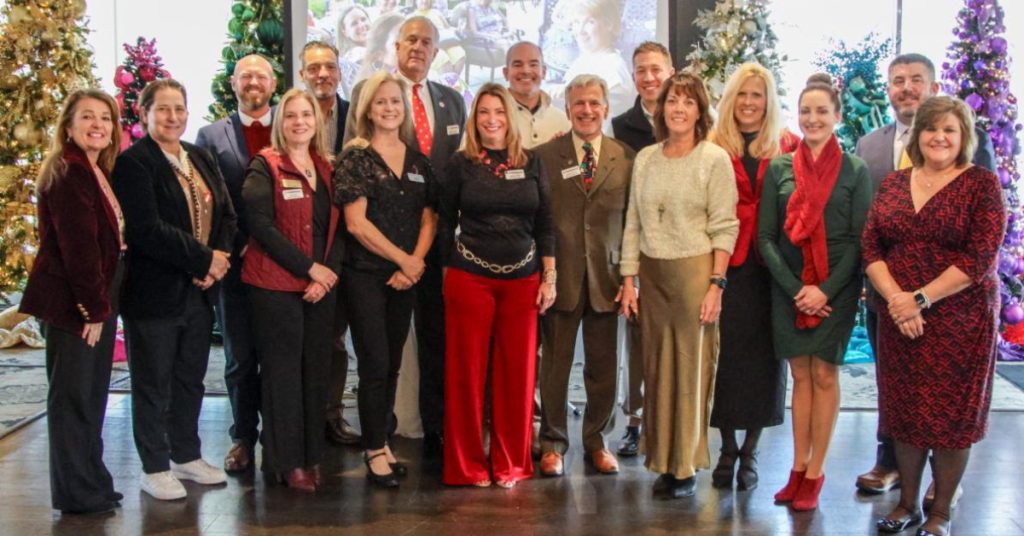Local cooperation bodes well for the future.
by Shari Held
Although the economy may not have rebounded 100 percent from the recent recession, things are picking up in Michiana. There's a new focus and a fresh, unified approach that bodes well for the future.
“We are seeing an unprecedented amount of cooperation,” says Jeff Rea, president and CEO of the Chamber of Commerce of St. Joseph County. “The two mayors in our county really get it. We have business leaders who really get it. We have economic development folks and chamber folks who are working together to raise our profile and make sure we appear on people's radar screens.”
South Bend Mayor Pete Buttigieg says communities that want to succeed need to connect to their neighbors and the rest of the world. “We can't go on viewing our economic development as a competition with Mishawaka, our closest community,” he says. “The reality is when an employer lands in South Bend, that creates jobs for people living in Mishawaka and vice versa.”
There's also renewed emphasis on ensuring word gets out about Michiana – an area Rea says has many strengths: affordable utilities, homes, transportation and logistics costs; abundance of human talent and some of the best institutions of higher learning in the nation and an excellent geographic location.
Both South Bend and Mishawaka are moving full-steam ahead with initiatives to foster greater economic development, and are meeting with encouraging success.
“Part of our challenge at the chamber is how we pull together all those different efforts into a common direction,” Rea says. “We feel like those pieces are now falling into place.”
Expansion and attraction on the rise
One lesson Michiana has taken to heart: Diversity is key to a healthier economy and multiple smaller companies are preferable to a single mega-employer. While manufacturing will always be a vital part of Michiana's economy, its role is evolving and new industries are making inroads.
“We also want to have a big healthcare presence and retail presence so it gives us some protection during a downturn,” says Mishawaka Mayor Dave Wood. “Diversification also provides a very livable community that better serves our citizens. We are a community that has outstanding health care, access to world-class retail operations and a great cost of living. And by the way, we're still a manufacturing community, too.”
Mishawaka is experiencing growth in all sectors and in all parts of the city, and its manufacturing sector is expanding. WellPet, Elixir Industries, B&B Molders, Maron Products and Nyloncraft, Inc., Mishawaka's largest manufacturer, have increased production lines, hired new or recalled employees, added shifts, begun working overtime or invested in new equipment.

“That's not the sexy stuff that people get excited about, but most economic development professionals would tell you it's core to a successful program,” Rea says. “Your own people have to be fans in investing and reinvesting before you can encourage new investment.”
Several area businesses made new investments in the area in 2012: Data Realty ($25 million) Federal Mogul ($21 million), WellPet ($20 million), Royal Adhesives & Sealants ($10 million), Lock Joint Tube ($8 million) and Tire Rack ($6.5 million) are just a few of the “notable” expansions for 2012, which add up to $125 million in investments and 728 new jobs created.
On the attraction side, the area added Hubbell-RACO distribution center (77 new jobs) and Pro-Air Flight (15 jobs).
Area companies with distinctive advanced manufacturing processes, patented processes or processes involving intellectual property are increasingly exporting goods. One such company – Manufacturing Technology, Inc. (MTI) – is a global leader in manufacturing machines used in friction welding processes worldwide. In an ironic twist, South Bend-based MTI builds machines used for automobile manufacturing in Mexico.
“That's how we survive in a globalizing economy,” Buttigieg says. “We move up the supply chain, up the value chain, and focus on doing things that only Americans can do.”
Hanging their hat on retail
Mishawaka is a regional leader in retail. Located in an area bounded by Chicago, Indianapolis, Grand Rapids and Fort Wayne, Mishawaka enjoys a draw of nearly 750,000 people.
“That has fueled some of our retail growth,” Wood says.
Recent highlights include renovations to Mishawaka's Ruth Chris's Steak House, the largest one in the country, and the addition of a Whole Foods Market ($5 million investment; 100 jobs).
“What's significant about this is that Whole Foods typically only operates in major markets, and Mishawaka is a city of 50,000,” Wood says. “The fact that they are here really puts us on the map for a lot of other development that ordinarily might not have looked to a market like Mishawaka.”
Data: a developing market
“We're making sure we're promoting what we've always been good at, but we're venturing into areas that are new to us,” Buttigieg says. “South Bend grew up around the automobile industry, and for a generation the loss of Studebaker threatened to define us. Now it's a different story.”

Proximity to the fiber-optic cable that carries the Internet from coast to coast and an abundance of affordable power has positioned South Bend as an ideal location for data centers. Ignition Park, a technology park that sits on the former site of the Studebaker factories, and Union Station Technology Center (Ivy Tower Building) are primed and ready to house data centers and other high-tech businesses. Data Realty ($25 million investment; 40 new jobs) opened in Ignition Park last year.
Build it and they will come
Mishawaka had made the extension of roads and services (sewers, water and electric) a cornerstone of its economic development plan.
“We think those things done properly really help us to attract economic development,” Wood says.
One focus area is Trinity Place, anchored by the $350 million St. Joseph Regional Medical Center, which opened in 2008. Mishawaka invested $11 million into the infrastructure – roads and services – around the area, opening up acres of property for development.
“Our initial investment is now paying off in development,” Wood says. So far the area has attracted several regional cancer care facilities, rehabilitation centers, senior living and memory care facilities and a dialysis center.
“We think our growth area is in the professional white collar office and medical professional services,” says Ken Prince, city planner for Mishawaka. “We've had a lot of existing businesses expand but we haven't had a new manufacturing building constructed in Mishawaka in probably the last 10 years.”
New roads and services are being built to open the area around State Road 331 and Capital Avenue and attracting interest. Converting the main north-south corridor though the downtown to five lanes, focusing on the downtown area and the U.S. 20 Bypass on the city's south side, is an ongoing initiative to encourage development. Both projects are slated to begin construction this year.
South Bend is assessing opportunities to convert one-way streets into two-way streets in the city's downtown. Currently most of the streets downtown are one-way which rapidly moves traffic through the city, which is not conducive to increasing traffic to retail establishments.
Downtowns coming back to life
Both Mishawaka and South Bend are experiencing a resurgence of growth.
“There's a new energy and excitement around downtowns in general and our downtown in particular,” Buttigieg says citing new developments in downtown residences. The old South Bend Central High School has been converted into trendy apartments and six upscale new construction homes sold quickly. Ten more are being built along the river. To accommodate the new residents, more restaurants and storefronts are opening in downtown South Bend.
“We are seeing a lot of small investment happening,” Wood says. “A lot of mom-and-pop shops, small retail stores and small locally owned restaurants are starting to come back. That's very encouraging.”
Two new buildings have been constructed in downtown Mishawaka, and the Ironworks Building, a three-year-old, high-end office building now has two tenants – Umbaugh Financial Consultants and Afdent Patient Friendly Dentistry. Across the river, the Center for Hospice Care Campus (70 jobs) is currently under construction.
At its low point, new construction in Mishawaka dropped from $100 million per year to just over $30 million. “Now we are back up to $50 million a year in new private construction,” Prince says. “Two years ago three new commercial buildings were constructed; last year 11 new commercial buildings were constructed. This year we are hoping that number will be significantly higher.”
Additional strategies
South Bend is using several non-traditional tactics to encourage economic development. One is its “1,000 houses in 1,000 days” initiative. Vacant and abandoned houses will be demolished or rehabbed, helping to better align the housing stock with community need and remove eyesores.
“Not only do they affect the property values in the neighborhoods, they affect the way the city looks and feels to visitors who are sizing us up,” Buttigieg says.
Another strategy for giving South Bend a competitive edge is the creation of a business-friendly environment. Citizens and businesses can call the new 311 line instead of trying to figure out what department they need. In addition, the city's economic development department now has one point of contact which greatly simplifies communications with businesses.
“We've seen that be pretty powerful in building the reputation of other communities and we think it will make a big difference here,” Buttigieg says.
In accordance with South Bend's human capital strategy, each year seven cream-of-the-crop graduates from a science and entrepreneurship program at Notre Dame are offered fellowships to devote a year working on community issues in South Bend. The goal is to deepen their ties to South Bend so they will stay in the area.
The city also works to ensure that employers and K-12 education leaders stay connected so future workers will have the right skills for positions that are becoming increasingly demanding.
Mishawaka just announced its major initiative to become a debt-free city, something Wood considers timely given the debate around the national debt.
“We are … putting our best fiscal foot forward,” Wood says. “We want to convey the fact that we've got a well-run government, that we are fiscally lean and very efficient.”


